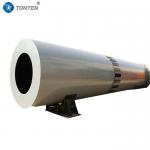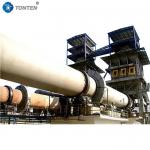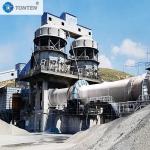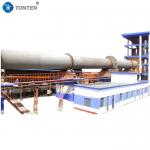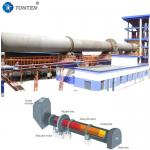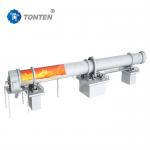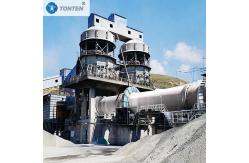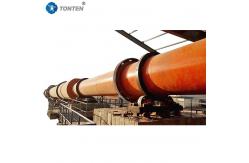Rotary Kiln Titanium Dioxide Cement Rotary Kiln Magnetite Rotary
Kiln
Rotary kiln introduction:
TONTEN machinery rotary kiln consists of a long, inclined
rotating drum, a steel thin-walled cylinder with a slope of 1-6%
installed on a supporting device. The material enters from one end
of the kiln and gradually moves to the another side. During
processing, materials are exposed to high temperatures and other
processing conditions, causing chemical and physical changes.
Rotary kiln is a commonly used equipment in industrial production
and is mainly used in processes such as ore sintering, cement
production and waste treatment.
Working principle:
1. Heating and sintering: Fuel and air are provided inside the
rotary kiln to form a high-temperature environment. The material is
gradually heated at high temperature, and the moisture and volatile
substances in it are evaporated and discharged. At the same time,
the sintering and solidification of the ore occur.
2. Reaction and transformation: At high temperatures, the chemical
components in the material react and transform. For example, in
cement production, limestone and clay are calcined to produce
clinker.
3. Cooling and processing: The material is gradually cooled in the
rotary kiln to stabilize and solidify the product. The cooling
process can be achieved by external air or cooling devices.
Main effect:
1. The rotary kiln is a high-temperature chemical reaction
equipment: different stages of clinker mineral formation have
different requirements. The rotary kiln can not only meet the heat
and temperature requirements of different stages and different
minerals, but also meet their residence time requirements.
2. The rotary kiln is a fuel combustion equipment: it has a large
combustion space and thermal field, and can supply sufficient
combustion air. It is a well-equipped combustion device, which can
ensure full combustion of fuel and can provide the necessary
materials for the calcination of cement clinker. of heat.
3. The rotary kiln is a heat exchange equipment with a relatively
uniform temperature field, which can meet the heat exchange
requirements at various stages in the clinker production process.
4. Lime kilns are mainly used in steel plants and iron plants
to treat desulfurization wastewater with activated lime and
light-burned dolomite.
Parameter:
| Type | Diameter of cylinder
(mm) | Length of cylinder
(mm) | Inclination
(%) | Capacity
(t/h) | Rotation speed
(rpm) | Power
(kw) | Weight
(t) |
| 1230 | 1200 | 30000 | 4 | 3 | 0.53-5.25 | 22 | 34 |
| 1632 | 1600 | 32000 | 4 | 3.5 | 0.53-5.25 | 15 | 46 |
| 1828 | 1800 | 28000 | 4 | 4 | 0.28-2.84 | 30 | 59 |
| 1850 | 1800 | 50000 | 4 | 5 | 0.28-2.84 | 30 | 80 |
| 1638 | 1600 | 38000 | 4 | 1.5-2 | 0.26-2.61 | 22 | 51 |
TONTEN machinery customer site:
